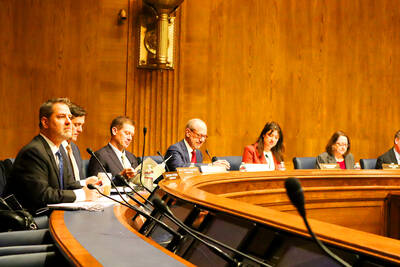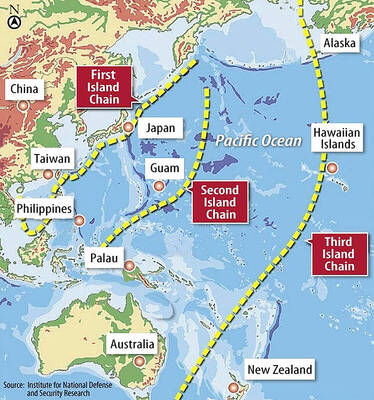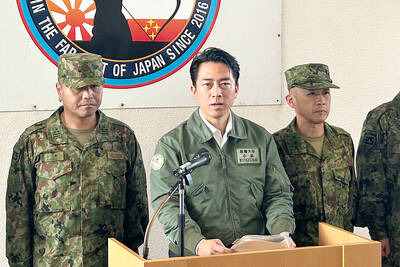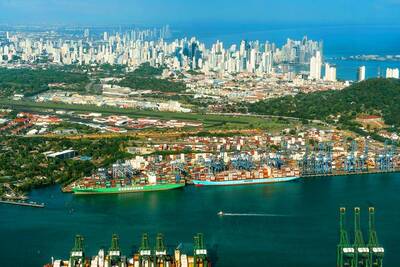Japan yesterday cleared the way for a resumption of nuclear power, four years after the world’s worst nuclear disaster in two-and-a-half decades led to the shutdown of all the country’s reactors and fueled public opposition to the industry.
Regulators said Kyushu Electric Power Co’s two-reactor Sendai nuclear plant had cleared safety hurdles introduced after a huge earthquake and tsunami triggered meltdowns and explosions at the Fukushima Dai-ichi plant in March 2011.
The Sendai plant still needs to go through operational checks before a restart, but these are expected to be completed without major hitches.

Photo: AP
The plume of radiation caused by the Fukushima disaster forced about 160,000 people from their homes, many of them never to return, in the worst nuclear disaster since Chernobyl in 1986.
The resulting closure of Japan’s reactors caused tens of billions of dollars in losses at utilities as they resorted to importing fossil fuels for power generation and paid for upgrades to meet tightened safety rules.
Some utilities decided to scrap older plants, leaving Japan with 43 operable reactors compared with 54 before the disaster.
The resumption of nuclear power is likely to be unpopular with the public after the catastrophe highlighted cosy links between utilities and the previous regulator.
The fumbled response to the meltdowns at Fukushima Dai-ichi added to the perception that nuclear power was too dangerous for such an earthquake-prone country as Japan.
Most public opinion polls have put opposition to restarts at about two-to-one, despite an average 20 percent rise in household electricity bills to cover the cost of imported fuel.
Japanese Nuclear Regulation Authority commissioners said in a televised meeting yesterday that the Sendai reactors had cleared final safety assessments. The restart has also received the approval of local authorities.
A local court last month rejected a legal bid to block the start-up by residents concerned about the plant’s vulnerability to nearby volcanoes. The residents have appealed against the decision.
Kyushu Electric hopes to restart the Sendai No. 1 reactor in late July, followed by the No. 2 reactor in late September.
The company, which reported a fourth year of losses for the 12 months through March, is desperate to restart the reactors to cut costs.
The approval came nearly two years after Kyushu Electric submitted an application for the screening. The Sendai plant won safety approval in September last year for its reactors and equipment, and was expected to be the first to restart.
Additional reporting by AP

LIMITS: While China increases military pressure on Taiwan and expands its use of cognitive warfare, it is unwilling to target tech supply chains, the report said US and Taiwan military officials have warned that the Chinese People’s Liberation Army (PLA) could implement a blockade within “a matter of hours” and need only “minimal conversion time” prior to an attack on Taiwan, a report released on Tuesday by the US Senate’s China Economic and Security Review Commission said. “While there is no indication that China is planning an imminent attack, the United States and its allies and partners can no longer assume that a Taiwan contingency is a distant possibility for which they would have ample time to prepare,” it said. The commission made the comments in its annual

DETERMINATION: Beijing’s actions toward Tokyo have drawn international attention, but would likely bolster regional coordination and defense networks, the report said Japanese Prime Minister Sanae Takaichi’s administration is likely to prioritize security reforms and deterrence in the face of recent “hybrid” threats from China, the National Security Bureau (NSB) said. The bureau made the assessment in a written report to the Legislative Yuan ahead of an oral report and questions-and-answers session at the legislature’s Foreign Affairs and National Defense Committee tomorrow. The key points of Japan’s security reforms would be to reinforce security cooperation with the US, including enhancing defense deployment in the first island chain, pushing forward the integrated command and operations of the Japan Self-Defense Forces and US Forces Japan, as

IN THE NATIONAL INTEREST: Deputy Minister of Foreign Affairs Francois Wu said the strengthening of military facilities would help to maintain security in the Taiwan Strait Japanese Minister of Defense Shinjiro Koizumi, visiting a military base close to Taiwan, said plans to deploy missiles to the post would move forward as tensions smolder between Tokyo and Beijing. “The deployment can help lower the chance of an armed attack on our country,” Koizumi told reporters on Sunday as he wrapped up his first trip to the base on the southern Japanese island of Yonaguni. “The view that it will heighten regional tensions is not accurate.” Former Japanese minister of defense Gen Nakatani in January said that Tokyo wanted to base Type 03 Chu-SAM missiles on Yonaguni, but little progress

IN THE MIDDLE: Some of the lawmakers defended the trip as an opportunity for investment, cooperation and to see models that could help modernize Panama A planned trip by some Panamanian lawmakers to Taiwan has unleashed the latest diplomatic spat with China as the Central American country tries to navigate the turbulent waters between the Asian superpower and the US. The Panamanian Ministry of Foreign Affairs and the US ambassador to the country on Wednesday criticized China’s diplomats in Panama for asking the lawmakers to cancel their trip to Taiwan, with the ministry accusing the Chinese embassy of “meddling” in its internal affairs. That followed comments from Panamanian President Jose Raul Mulino a week earlier saying that the planned Taiwan trip did not have the approval of